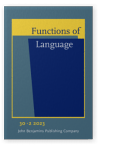Vol. 30:2 (2023) ► pp.137–158
Do ‘say’ verbs really grammaticalize into complementizers through clause combination?
Evidence from Chinese shuō ‘say’
When a ‘say’ clause is combined with a quoted-speech clause, one of two hypothetical pathways may be followed: (a) a complementation pathway on which the ‘say’ clause takes the quoted-speech clause as its complement clause and thus becomes its matrix clause; (b) a conjoining pathway which involves no syntactic operation but rather the loss of a prosodic gap between the two. Following the second pathway, ‘say’ may become grammaticalized into a quotative particle. On neither pathway is ‘say’ grammaticalized into a complementizer. It is proposed that cross-linguistically so-called ‘say’ complementizers, including the alleged Chinese complementizer shuō, are more likely to be not complementizers but rather quotative particles.
Article outline
- 1.Introduction
- 2.Chinese clause-introducing shuō: A paradox
- 3.Two hypothetical pathways for clause combination in Chinese
- 3.1Hypothetical complementation pathway
- 3.2Hypothetical conjoining pathway
- 4.Re-examining the syntactic status of the so-called Chinese shuō complementizer
- 5.Re-examining so-called ‘say’ complementizers in other languages
- 6.Conclusion and further comments
- Acknowledgements
- Notes
- Abbreviations
-
References
